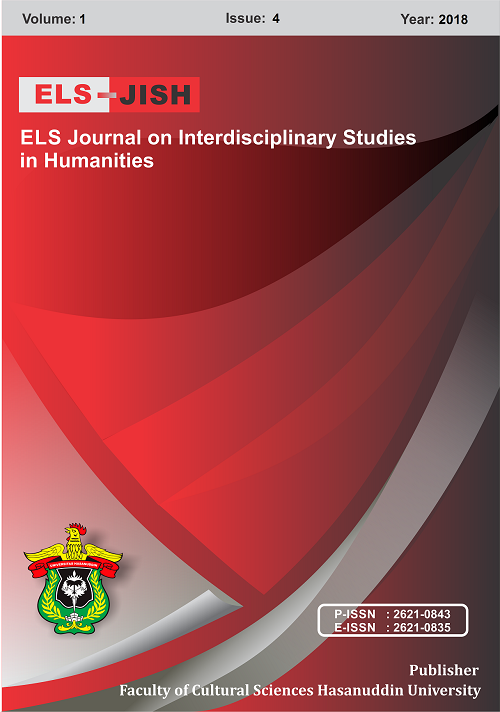Similar Articles
- Yohanis Rongre, Word-Level Translation Techniques in Medical Terms From English into Indonesian , ELS Journal on Interdisciplinary Studies in Humanities: Vol. 1 No. 1 (2018): March
- Tira Nur Fitria, Translation Technique of English to Indonesian Subtitle in “Crazy Rich Asian” Movie , ELS Journal on Interdisciplinary Studies in Humanities: Vol. 3 No. 1 (2020): MARCH
- Elvira Septevany, The Comparison Of Mandarin Aspects and Indonesian Aspects , ELS Journal on Interdisciplinary Studies in Humanities: Vol. 1 No. 3 (2018): SEPTEMBER
- Nirwana AR, Suraya Mukadar, Learners’ Intrigue and Attitude Towards Presenting Self-Documentaries Technique in Speaking Skill , ELS Journal on Interdisciplinary Studies in Humanities: Vol. 4 No. 4 (2021): DECEMBER
- Khadijah Maming, Amir Patintingan, Sianna, Delfiana, Familiarizing Students with a Friendly Learning Activity in Enriching English Vocabulary: Memorization Technique , ELS Journal on Interdisciplinary Studies in Humanities: Vol. 6 No. 2 (2023): JUNE
- Nur Alifah Annisa Jumrah, Mirah Azizah, The Effectiveness and Students’ Perceptions on Learning Tenses Through Mind Mapping Technique on Elementary Level at an Education and Training Institute in Indonesia , ELS Journal on Interdisciplinary Studies in Humanities: Vol. 4 No. 1 (2021): MARCH
- Tira Nur Fitria, Translation Technique of English into Indonesian Subtitle in “Bhaijan Bajrangi” Movie , ELS Journal on Interdisciplinary Studies in Humanities: Vol. 2 No. 2 (2019): JUNE
- Amelia Biringkanae, The Use Of SQ3r Technique in Improving Students` Reading Comprehension , ELS Journal on Interdisciplinary Studies in Humanities: Vol. 1 No. 2 (2018): June
- Intan Firdaus, Gayus Immanuelle Putranda Nauly, An Analysis of Cultural Terms Translation in ‘Chef’ Movie Script , ELS Journal on Interdisciplinary Studies in Humanities: Vol. 5 No. 2 (2022): June
- Muhammad Ridha Anugrah Latief, A.ST.Aldilah Khaerana, Andi Inayah Soraya, Translation Analysis: Syntactic, Semantic, and Pragmatic Strategies Used in Translating A Website of an Academic Institution , ELS Journal on Interdisciplinary Studies in Humanities: Vol. 5 No. 3 (2022): September
You may also start an advanced similarity search for this article.






